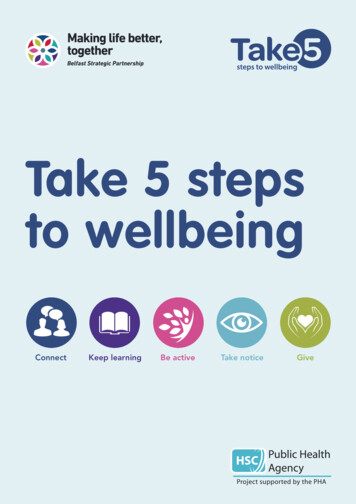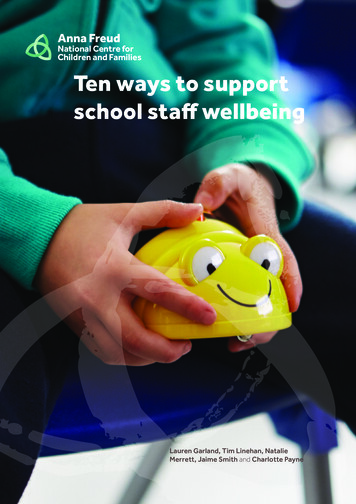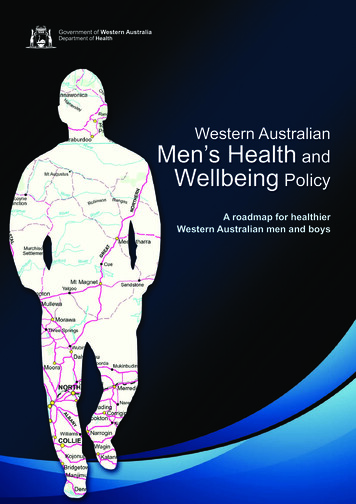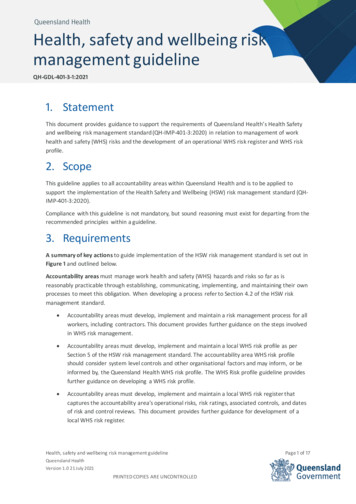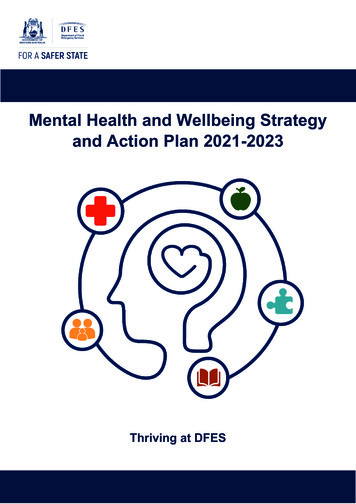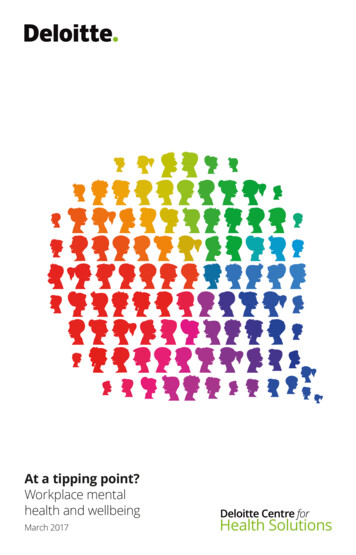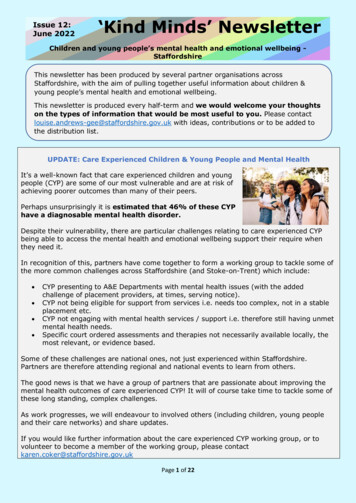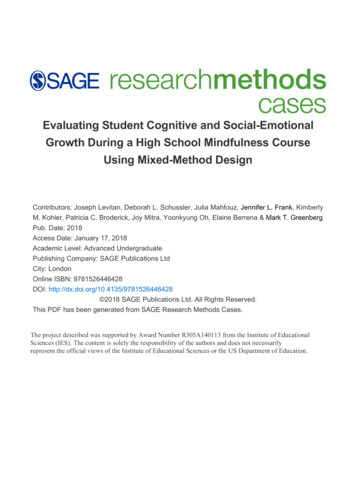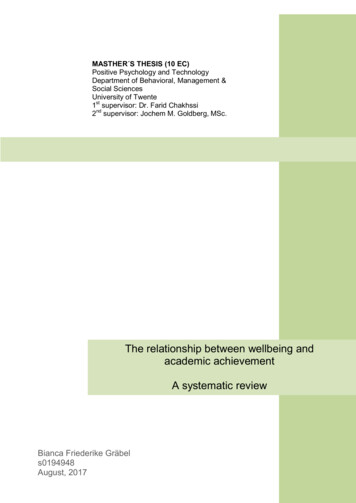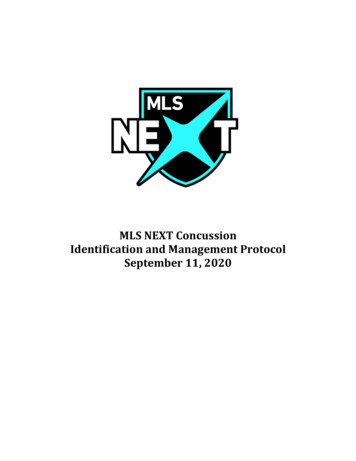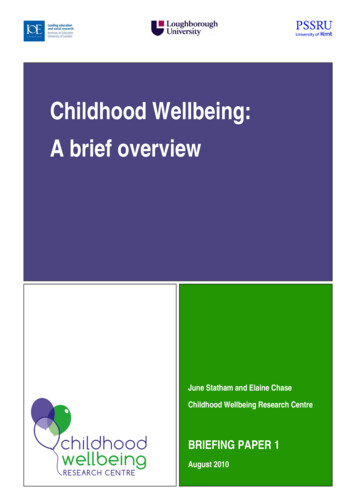
Transcription
Health and WellbeingProfile 2017
ContentsTHE CITY OF MORELAND – PEOPLE AND PLACES . 6The local area: . 6Population and Growth: . 7Age Structure:. 8Cultural Diversity: . 8Moreland People at a Glance: . 9Socio-economic Differences and Inequality:. 9THE CITY OF MORELAND ENVIRONMENTS . 11THE CITY OF MORELAND – HEALTH AND WELLBEING . 12PHYSICAL HEALTH . 13Life Expectancy:. 13Self-Reported Health:. 13Disability: . 14Bodyweight: . 15Chronic Disease and Health Priority Areas:. 15Hospital Admissions: . 16Oral Health: . 17Health Checks: . 18Sexual and Reproductive Health: . 18What this means for Moreland: . 19MENTAL HEALTH . 20Subjective Wellbeing: . 20Work/Life Balance: . 21Resilience: . 212
Low Gender Equality Score: . 22Psychological Distress: . 23Anxiety or Depression: . 23What this means for Moreland: . 24PHYSICAL ACTIVITY. 25Exercise and physical activity: . 25Barriers to increasing exercise: . 27Type of exercise undertaken: . 27What this means for Moreland: . 29FOOD AND NUTRITION: . 30Fresh fruit and vegetable consumption: . 30Takeaway/ fast food consumption: . 32Barriers to improving nutrition: . 33Soft Drink Consumption: . 34Food insecurity: . 34Food access: . 35Growing your own food: . 36What this means for Moreland: . 36ALCOHOL AND OTHER DRUGS . 38Alcohol Consumption: . 38Drug Use: . 40Smoking: . 41What this means for Moreland: . 42SCREENING AND HEALTH CHECKS . 43Health check-ups:. 433
Eye check-ups: . 43What this means for Moreland: . 43SOCIAL INCLUSION . 44Feeling of belonging and connectedness: . 44Internet Access: . 45What this means for Moreland: . 46CRIME AND SAFETY . 47Crime rates: . 47Family violence: . 48Road injuries: . 48Perceptions of safety:. 49What this means for Moreland: . 50GAMBLING HARM. 51Types of Gambling: . 51Gambling on Electronic Gaming Machines (EGMS): . 52What this means for Moreland: . 52INCOME AND EMPLOYMENT . 53Household Income . 53SEIFA Index of Disadvantage: . 53Unemployment: . 54What this means for Moreland: . 54HOUSING. 55Housing tenure: . 55Housing affordability: . 55Housing stress: . 574
Homelessness: . 58What this means for Moreland: . 59TRANSPORT . 61Car ownership: . 61Transport Indicators: . 62Non work or study related bicycle and public transport usage: . 62What this means for Moreland: . 63EDUCATION . 64Non-school qualifications: . 64Disengaged youth: . 64Highest level of schooling: . 64What this means for Moreland: . 65ENVIRONMENT . 66Climate change: . 66Access to parks and open space: . 66Environmentally sustainable activities: . 66Moreland Environmental Statistics: . 68What this means for Moreland: . 68DATA SOURCES. 695
THE CITY OF MORELAND – PEOPLE AND PLACESThe local area:Moreland is a municipality in the inner north of Melbourne, Australia. Its local government is Moreland CityCouncil. The City of Moreland covers 50.9 square kilometres and is one of Melbourne’s most populousmunicipalities.The City of Moreland lies between 4 and 14 kilometres north of central Melbourne. It is bordered by the MooneePonds Creek to the west, Merri Creek to the east, Park Street to the south and the Western Ring Road to thenorth.The City of Moreland covers the suburbs of Brunswick, Brunswick East, Brunswick West, Coburg, Coburg North,Fawkner, Glenroy, Gowanbrae, Hadfield, Oak Park, Pascoe Vale, and Pascoe Vale South. Small sections of thesuburbs of Fitzroy North and Tullamarine are also located in the City.The map below shows all of the suburbs contained within the municipality of Moreland.6
Population and Growth:The estimated resident population of Moreland was 166,770 in June 2015, with approximately 67,831households in 2016. Population projections suggest significant growth will occur in Moreland over the comingyears. It is predicted that the Moreland population will be 214,320 in 2036 and that there will be 85,919households in the municipality. This equates to a population increase of 39% between 2011 and 2036.Population Forecasts - 2011 to 2036250,00079% of growthto occur between2011 and 2026200,000150,000100,00050,0000Population ,663201,594208,316214,320Source: ID Population Forecasts, 2014Some of the key issues facing the municipality include: More than 70% of the population growth is predicted to occur in the southern half of the municipality.Brunswick East is expected to have the greatest proportional increase in population with a predictedincrease of 111% between 2011 and 2036. Although Brunswick East is a comparatively small suburb, itis also predicted to have the largest numerical population increase, with an estimated 11,428 additionalpeople by 2036, bringing the population to 21,728.Brunswick will also experience a significant population increase of 48.5%.The most significant increase in the population is predicted to occur between 2011 and 2021.Much of the population increase will come from increased medium density development.Moreland is experiencing rapid and significant population growth, which is predicted to add more than 60,000people to the community between 2011 and 2036. Because the majority of the population increase is likely tooccur in the coming decade and in the southern suburbs of the municipality, adequate infrastructure will need toaccommodate the expanding population and their health needs, including: adequate access to fresh food,adequate recreation facilities,parks and open space,appropriate and affordable housing,sufficient public transport networks,increased family and elderly support services, andfacilities for active transport modes.7
This will be challenging given half of the predicted population increase will occur in the small and already denselypopulated suburbs of Brunswick and Brunswick East.Age Structure:Moreland has consistently higher proportions of residents in all age groups over 70 years, when compared withthe Melbourne average. Moreland also has higher proportions of adults aged 20-39 and smaller proportions ofchildren and residents aged 40-69. In recent years, Moreland has experienced something of a baby boom andsince the 2006 Census has seen a 12.2% increase in the number of residents aged 0-4 years.Proportion of age groups in Moreland (ABS Census, years er Melbourne land0-9yearsSource: ABS Census of Population and Housing, 2011Cultural Diversity:Moreland has one of the most diverse populations in Melbourne.Some of the key issues to consider include the following: Moreland has a significant population of overseas born residents who constitute more than one-third(33.8%) of the population. Of those born overseas, 86% come from non-English speaking backgrounds Nearly 40% of Moreland residents speak a language other than English at home, while the proportion ofresidents who speak English only at home is declining. In the North Statistical Local Area, only 47% ofresidents speak English only at home. The languages spoken in Moreland are becoming more diverse and challenging for deliveringinformation. Two trends are happening simultaneously – the number of languages spoken is increasing,while the language groups with the greatest number of speakers are declining. Moreland has a significant population who speak English not well or not at all. Moreland has one of the fastest growing Muslim communities in Melbourne, who are largely situated inMoreland’s North. Muslims now constitute 25% of the total population in Fawkner, 17% of Hadfield and16% of Glenroy.These trends indicate that Moreland will need to devote significant resources to ensuring that its non-Englishspeaking residents are considered in any health promotion strategy. This may be challenging with the increasingnumber of languages to be catered for and with smaller proportions of residents speaking some of the moredominant languages. The different cultural backgrounds of residents will require a complex understanding of8
cultural practices in order to appropriately deliver health services or promote activities such as physical exerciseand improved nutrition. It is increasingly likely that some cultural practices will need to be accommodated;especially those that may require separate facilities for women or to allow cultural or religious practices to beobserved.Moreland People at a Glance:PopulationEstimated Resident Population (June 2015)Median AgeCultural DiversityResidents born overseasSpeak a language other than English at homeAboriginal or Torres Strait IslanderAustralian BornPoor English proficiency (speaks English not well or not at all)City of Moreland166,77035Main countries of birth (other than Australia)Italy, India, Greece, UK, Lebanon,China, New Zealand, Turkey,Pakistan, NepalItalian, Arabic, Greek, Turkish,Mandarin, Urdu, Nepali,Vietnamese, Punjabi, HindiCatholic, No Religion, Islam, GreekOrthodox, Anglican, Hinduism,Buddhism, Uniting Church1,163India, Pakistan, Syria, China,Philippines, Nepal, Iraq, IranMost common languages, other than EnglishMost common religious affiliationNew settler arrivals (2016 calendar year)Main countries of birth for new settlers (2016)33.8%39.4%0.5%60.1%7.3% (of people born overseas)Socio-economic Differences and Inequality:One of the most difficult issues for Moreland to address is the health needs of those who are most socioeconomically disadvantaged. People of lower socio-economic status tend to have poorer health outcomes overalland are less likely to either seek treatment or be able to afford treatment for chronic disease or injury. Typically,people of lower socio economic status: Tend to self-report their health more negatively.Are more likely to have chronic health issues such as arthritis, asthma, bronchitis/emphysema,diabetes, dental problemsAre more likely to be overweight or obese.Tend to make poorer food choicesAre more likely to engage in unhealthy behaviours such as smoking and males are more likely toconsume alcohol at medium to high risk levels.Are less likely to have taken preventative health actions such as immunising children against contagiousdiseases, or having certain cancer screening tests.Least likely to have private health insurance.This has significant implications for our disadvantaged in the municipality. While Moreland is ranked 8th mostsocio-economically disadvantaged municipality in metro Melbourne, there are clear pockets of greater socio9
economic disadvantage found in the suburbs of Fawkner, Glenroy and Hadfield. These areas have highproportions of vulnerable population groups including: Low income earners (more than 33% of Fawkner, Hadfield and Glenroy households are in the lowestincome quartile, earning less than 624 per week)People with low proficiency in EnglishHigher proportions of people who speak a language other than English at homeNew migrantsUnemployedPeople with low levels of qualificationsHigher proportions of single parentsHigher proportions of older lone person householdsHigher than average experience of food insecurityThese factors are likely increase the vulnerability of these residents to experiencing negative health outcomes.The high proportions of people in the lowest quartile for income means they need to juggle rising householdpressures on limited incomes, especially increasing housing and utility costs. Research shows these pressuresoften results in basic health care, food, recreation and warmth being sacrificed to make ends meet. Withoutassistance, many may experience worsening health for themselves and their families. Prioritising the needs ofthe community’s most vulnerable therefore becomes critical to improving the overall health of the community.The City of Moreland SEIFA Index of Disadvantage measures the relative level of socio-economic disadvantagebased on a range of Census characteristics. It gives a general view of the relative level of disadvantage in onearea compared to others and is used to advocate for an area based on its level of disadvantage. The index isderived from attributes that reflect disadvantagesuch as low income, low educational attainment,high unemployment and jobs in relativelyunskilled occupations. When targeting services todisadvantaged communities, it is important toalso look at these underlying characteristics asthey can differ markedly between areas withsimilar SEIFA scores and shed light on the typeof disadvantage being experienced.This map illustrates the relative disadvantageexperienced across the municipality. A highnumber on the SEIFA index indicates acomparatively low level of disadvantage versus alow number which indicates comparatively highlevels of disadvantage.10
THE CITY OF MORELAND ENVIRONMENTSECONOMIC environment – includes secure employment,socio economic status, income levels and being able to affordnecessities like food and shelter. The City of Moreland is ranked the 8th mostsocio-economically disadvantaged municipality in theMelbourne metro area with a SEIFA rating of 998.1.Within Moreland, there is more extreme disadvantagein the suburbs of Fawkner, Glenroy, Hadfield andCoburg NorthThe median weekly personal income is 551The median weekly household income is 1,21540.1% of workers are professionals or managers48.3% of residents earn 599 or less per week6.2% of the population are unemployed51.9% of households report experiencing moderate toheavy housing payment stressMedian weekly household income rose 66.4% between2001 and 2011, while the median weekly rental paymentrose 100% and mortgage payment rose 109.2%The median house price rose 121% between 2006and 201145% of residents agree it is still affordable to live intheir areaOnly metropolitan municipality in the Top 10 forfood insecurity34.4% have a Health Care cardBUILT environment – includes access to housing, shops,playgrounds, recreation facilities, roads and footpaths,community facilities and transport infrastructure The majority of dwellings are separate houses (67%)30.9% live in medium density dwelling, while 5.2% live inhigh density accommodation32.6% of Moreland households own their houses, 27.6%are being purchased and 32.4% are being rentedOf those who rent, 7.8% are in public housingOver the past decade, public housing stockhas decreased88% of residents agree their local shopping areaprovides for their basic needs49% of residents agree the housing being built isappropriate for the area52.6% of residents use a private car, 22.9% use publictransport, 4.9% use a bicycle, and 2.3% walk to get towork.SOCIAL environment – includes our connection to thecommunity and sense of belonging, access to supportservices, feelings of safety, access to arts, culture anddiversity, recreation and leisure. 87.1% of households have an Internet connectionat homeResidents most often use the Internet for email,information/research, social networking and paying bills22.6% of residents are attending an educational institution(9.3% at university or TAFE)27.3% of households are couples with children, while23.3% are couples without children and 9.4% are singleparent households25.8% are lone person households and 7.8% aregroup households92% of residents agree that cultural diversity enrichescommunity life87% of residents agree they can get to know theirneighbours41% of residents say they have attended a localcommunity event in the past 6 months36% of households includes someone who works asa volunteer54.8% of residents gamble on Scratchies/Tattslotto,21.5% gamble on the pokies and 20.2% gamble on horseracing at least occasionally84% of residents agree that they feel part of theircommunityNATURAL environment – includes access to open spacessuch as parks, reserves and gardens, clean air and water,and protection from the impacts of climate change 90% of residents agree that there are good parks andopen areas in their neighbourhood74% of residents agree that the environment is beingmanaged by Council for the benefit of current andfuture generations89% felt action to prevent climate change is important64% of residents agree they are adequately informedabout how to reduce the impact of climate change94% of households use a recycling bin, 57% userecyclable shopping bagsIn a year 30,425 tonnes of rubbish went to landfill, 16,419tonnes of recycling collected, 8,598 tonnes of green wastecollected and 5,040 trees were plantedSources: ABS Census, Moreland Household Survey, MorelandCommunity Indicators11
THE CITY OF MORELAND – HEALTH AND WELLBEINGThe following pages provide a snapshot of health and wellbeing in Moreland. This profile covers: Physical HealthMental HealthPhysical ActivityFood and NutritionAlcohol and Other DrugsScreening and Health ChecksSocial InclusionCrime and SafetyProblem GamblingIncome and EmploymentHousingTransportEducationEnvironment12
PHYSICAL HEALTHLife Expectancy:The life expectancy of Moreland residents is increasing, although it remains just below the state average. The lifeexpectancy of children born in Moreland between 2008 and 2011 is 84.4 years for girls, and 79.1 years for boys.The life expectancy of females in Moreland is more than 5 years higher than males. The female life expectancyis the same as the Victorian figure of 84.4 years, but the life expectancy for males is lower than the Victorianfigure at 80.3 years.Source: Vic Dept. of Health LGA profiles 2012Self-Reported Health:In the 2015 Moreland Household survey, nearly two-thirds of respondents (63.1%) reported their health as“Excellent’ or ‘Very Good’. However, the 2015 result was a decline from the 2013 survey result. Only 13.8%reported their health as “Fair” or “Poor”. A positive assessment of health is known to decline with age andanalysis of the data by age group shows this trend to be evident, with 35.1% of 61 to 75 year olds and 11.2% of76 years and older describing their health as ‘excellent’ or ‘very good’.Self-Reported Health40%35%30%25%20%15%10%5%0%ExcellentVery GoodGoodFairPoorCan't ce: Moreland Household survey, 2015These results differ from the 2014 Victorian Population Health survey where only 38.3% reported their healthstatus as “Excellent” or “Very Good” and a much greater proportion (25.3%) reporting their health as “Fair” or“Poor”. These results differed markedly from the previous survey where a greater proportion reported their healthas “Excellent” or “Very Good” (42.4%) and a lower proportion reported their health as “Fair” or “Poor” (18
Most common religious affiliation Catholic, No Religion, Islam, Greek Orthodox, Anglican, Hinduism, Buddhism, Uniting Church . Least likely to have private health insurance. This has significant implications for our disadvantaged in the municipality. While Moreland is ranked 8th most
